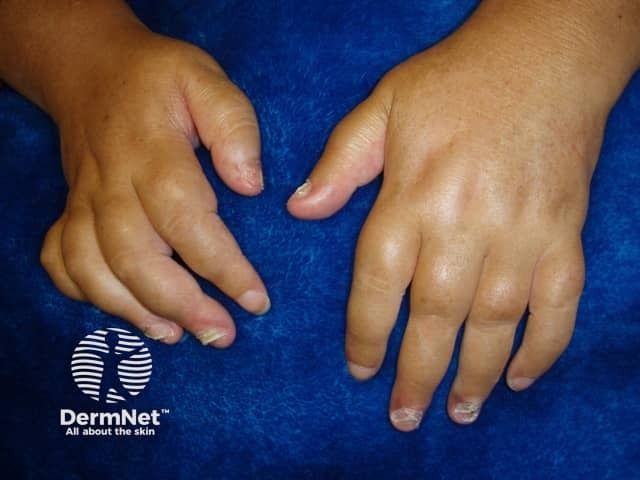- Case-Based Roundtable
- General Dermatology
- Eczema
- Chronic Hand Eczema
- Alopecia
- Aesthetics
- Vitiligo
- COVID-19
- Actinic Keratosis
- Precision Medicine and Biologics
- Rare Disease
- Wound Care
- Rosacea
- Psoriasis
- Psoriatic Arthritis
- Atopic Dermatitis
- Melasma
- NP and PA
- Skin Cancer
- Hidradenitis Suppurativa
- Drug Watch
- Pigmentary Disorders
- Acne
- Pediatric Dermatology
- Practice Management
- Prurigo Nodularis
- Buy-and-Bill
News
Article
Study Explores PsA Patient and Clinician Priorities
Author(s):
Key Takeaways
- Psoriatic arthritis significantly impacts health-related quality of life, affecting up to 30% of psoriasis patients.
- Managing PsA requires collaborative decision-making due to its complex and multifaceted nature.
Effective PsA management requires balancing clinical goals with patient-reported challenges like fatigue and daily disruptions.
Psoriatic arthritis (PsA) impacts up to 30% of individuals with psoriasis, which itself affects 1 to 3% of the global population. PsA’s hallmark features include joint and axial inflammation combined with skin involvement, imposing a substantial disease burden and severely affecting health-related quality of life (HRQoL).1 Managing PsA presents unique challenges due to its complex nature and multifaceted manifestations, requiring collaborative decision-making between patients and clinicians.2,3
“The data revealed patient concerns about the future and life limitations as well as current challenges and impact on almost all aspects of daily life; because of the personalized nature of some of these areas, they could not be the focus in broader consensus projects and more research is needed,” researchers behind the study wrote. “Physicians prioritized disease manifestations but also the common understanding of disease management goals; however, some of the other topics important to patients may not be commonly discussed in a clinical visit.”
Shared Decision-Making in PsA Management
Uncontrolled inflammation in PsA can lead to irreversible structural damage and worsen comorbidities, underscoring the importance of early and effective intervention.1 Recent treatment guidelines emphasize lowering global inflammation as a primary goal. However, the multidimensional nature of PsA complicates assessment, with varying disease impacts across individuals. This discrepancy in disease activity perceptions between patients and clinicians is well-documented and extends to physical, psychological, and social aspects of disease burden.4
Patients and clinicians often prioritize different aspects of disease activity and HRQoL. For example, patients may emphasize fatigue, sleep quality, and daily activity disruptions, while clinicians focus on specific manifestations such as dactylitis, enthesitis, and structural damage.5 These differing perspectives highlight the need for patient-centric research to bridge gaps in understanding and improve shared treatment planning.6
Study Methods and Materials
To address these challenges, a multicenter US-focused study was conducted to explore patient and clinician perspectives on PsA.7 This research aimed to identify and prioritize PsA concerns through extensive input from patients and expert clinicians. The study design included patient focus groups, validated patient-reported outcomes (PROs), and a comprehensive prioritization exercise.
Patients were recruited from 3 major rheumatology practices across the US and represented diverse demographics, disease durations, and characteristics. Participants completed PRO instruments, including the Health Assessment Questionnaire-Spondyloarthropathies, the Short-Form Health Survey, the Beck Depression Inventory II, and the Work Productivity and Activity Impairment instrument.
Key Findings
The study revealed both overlap and differences in priorities between patients and clinicians. Both groups emphasized arthritis, pain, fatigue, and disease activity as key concerns. However, researchers found patients prioritized issues affecting daily life, such as sleep quality, access to care, and future health uncertainty, while clinicians focused on clinical manifestations and long-term structural outcomes.
Access to care and future health uncertainty emerged as critical patient concerns, particularly in the US healthcare system, where insurance coverage and treatment approvals pose significant challenges. These findings underscore the vulnerability patients feel regarding their ongoing care and highlight the need for advocacy efforts to ensure equitable access to specialized treatments.
Implications for Clinical Practice
The study underscores the importance of integrating patient perspectives into clinical care and research. By identifying areas of concordance and discordance, clinicians can better understand the personalized impact of PsA and address patients’ unique concerns. The development of a patient-centered communication tool could facilitate shared decision-making by capturing real-time concerns and priorities, enhancing the patient-clinician relationship.
The study suggested that future research should focus on refining these findings and developing tools to assess granular, individualized aspects of PsA. Researchers believe that emphasizing patient-centric outcomes will improve HRQoL and foster a holistic approach to disease management. They also stated addressing “what matters” to patients in routine clinical care will empower individuals, improve communication, and lead to more effective and satisfying treatment outcomes.
References
- FitzGerald O, Ogdie A, Chandran V, et al. Psoriatic arthritis. Nat Rev Dis Primers. 2021;7(1):59. doi:10.1038/s41572-021-00293-y
- Coates LC, Soriano ER, Corp N, et al. Group for research and assessment of psoriasis and psoriatic arthritis (GRAPPA): updated treatment recommendations for psoriatic arthritis 2021 [published correction appears in Nat Rev Rheumatol. 2022 Dec;18(12):734. doi: 10.1038/s41584-022-00861-w]. Nat Rev Rheumatol. 2022;18(8):465-479. doi:10.1038/s41584-022-00798-0
- Singh JA, Guyatt G, Ogdie A, et al. Special article: 2018 American college of rheumatology/national psoriasis foundation guideline for the treatment of psoriatic arthritis. Arthritis Care Res (Hoboken). 2019;71(1):2-29. doi:10.1002/acr.23789
- Landewé RBM, van der Heijde D. Use of multidimensional composite scores in rheumatology: parsimony versus subtlety. Ann Rheum Dis. 2021;80(3):280-285. doi:10.1136/annrheumdis-2020-216999
- Desthieux C, Hermet A, Granger B, et al. Patient-physician discordance in global assessment in rheumatoid arthritis: A systematic literature review with meta-analysis. Arthritis Care Res (Hoboken). 2016;68(12):1767-1773. doi:10.1002/acr.22902
- Garrido-Cumbrera M, Poddubnyy D, Gossec L, et al. The European map of axial spondyloarthritis: Capturing the patient perspective-an analysis of 2846 patients across 13 countries. Curr Rheumatol Rep. 2019;21(5):19. Published 2019 Mar 12. doi:10.1007/s11926-019-0819-8
- Mease PJ, Husni ME, Siegel E, et al. What matters in psoriatic arthritis: A comparison of patient and clinician perspectives. ACR Open Rheumatol. 2025;7(1):e11781. doi:10.1002/acr2.11781







